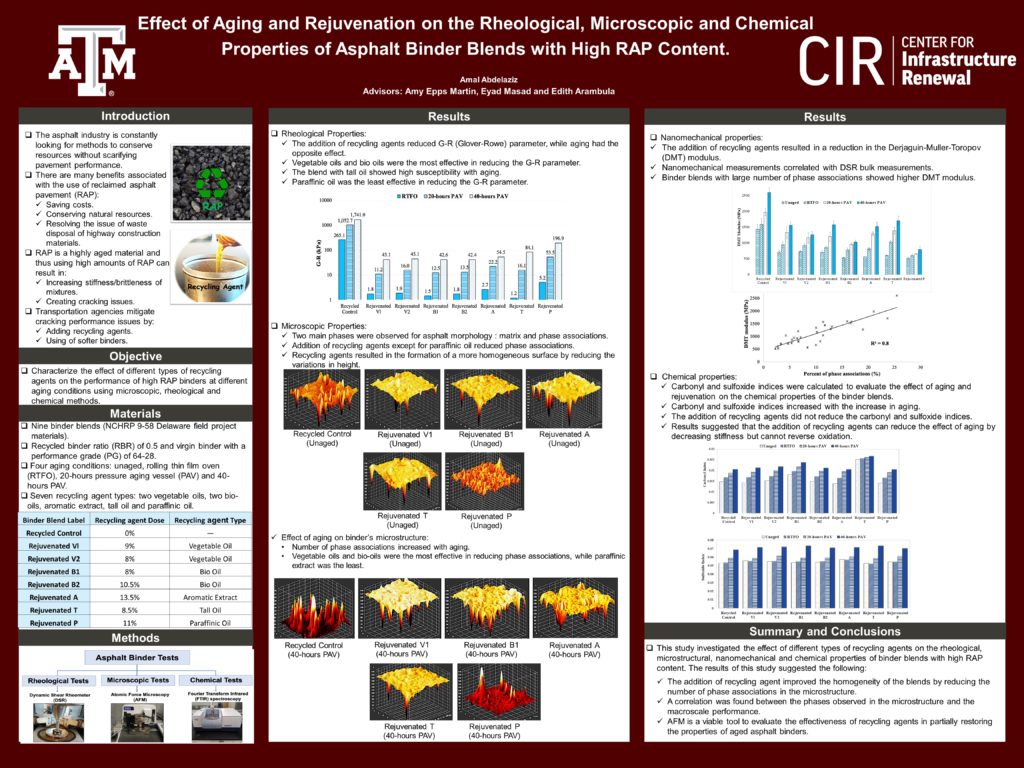Introduction
 Although, the use of reclaimed asphalt pavement (RAP) is associated with many environmental and cost benefits, it may increase the risk of mixture cracking due to its aging and brittleness characteristics. These characteristics are typically addressed by using a softer virgin binder grade or recycling agents (rejuvenators). Recycling agents can facilitate the use of higher amounts of RAP materials, however, adding them in excessive amount can result in rutting issues. Thus, it is necessary to select the proper type and amount of recycling agent to ensure its compatibility with the RAP binder and to improve the cracking resistance without negatively impacting the rutting resistance. This study evaluates the effect of different types of recycling agents (vegetable oils, aromatic extract, paraffinic oil, bio-oils and tall oil) in improving the properties of asphalt binder blends with high RAP content using rheological, microscopic and chemical tools. Asphalt binder blends were prepared considering four different aging conditions: unaged, rolling thin film oven (RTFO), 20-hours Pressure Aging Vessel (PAV) and 40-hours PAV. An atomic force microscopy (AFM) was used to characterize the microstructural and nanomechanical properties of the asphalt binder blends. Dynamic shear rheometer (DSR) tests were conducted to characterize the rheological properties of the asphalt binder blends at intermediate temperatures. In addition, Fourier transform infrared spectroscopy (FTIR) tests were performed to evaluate the chemical properties of the asphalt binder blends. AFM results indicated that recycling agents did not reproduce the microstructure of the unaged asphalt binder blends. However, the addition of recycling agents partially restored the nanomechanical properties of aged asphalt binder blends by reducing the modulus. AFM results also showed to correlate with bulk measurements obtained from DSR tests. Vegetable oils and bio-oils showed to be the most effective in reducing modulus and improving homogeneity of the blend, while paraffinic oil was the least effective. Tall oil showed to be effective at lower aging conditions, however its performance was significantly reduced with aging. Finally, chemical characterization suggested that the addition of recycling agents did not reverse oxidation due to aging. The results of the study suggest that a combination of microscopic, chemical and macroscopic tests is an effective approach to evaluate the properties of rejuvenated asphalt binder blends.
Although, the use of reclaimed asphalt pavement (RAP) is associated with many environmental and cost benefits, it may increase the risk of mixture cracking due to its aging and brittleness characteristics. These characteristics are typically addressed by using a softer virgin binder grade or recycling agents (rejuvenators). Recycling agents can facilitate the use of higher amounts of RAP materials, however, adding them in excessive amount can result in rutting issues. Thus, it is necessary to select the proper type and amount of recycling agent to ensure its compatibility with the RAP binder and to improve the cracking resistance without negatively impacting the rutting resistance. This study evaluates the effect of different types of recycling agents (vegetable oils, aromatic extract, paraffinic oil, bio-oils and tall oil) in improving the properties of asphalt binder blends with high RAP content using rheological, microscopic and chemical tools. Asphalt binder blends were prepared considering four different aging conditions: unaged, rolling thin film oven (RTFO), 20-hours Pressure Aging Vessel (PAV) and 40-hours PAV. An atomic force microscopy (AFM) was used to characterize the microstructural and nanomechanical properties of the asphalt binder blends. Dynamic shear rheometer (DSR) tests were conducted to characterize the rheological properties of the asphalt binder blends at intermediate temperatures. In addition, Fourier transform infrared spectroscopy (FTIR) tests were performed to evaluate the chemical properties of the asphalt binder blends. AFM results indicated that recycling agents did not reproduce the microstructure of the unaged asphalt binder blends. However, the addition of recycling agents partially restored the nanomechanical properties of aged asphalt binder blends by reducing the modulus. AFM results also showed to correlate with bulk measurements obtained from DSR tests. Vegetable oils and bio-oils showed to be the most effective in reducing modulus and improving homogeneity of the blend, while paraffinic oil was the least effective. Tall oil showed to be effective at lower aging conditions, however its performance was significantly reduced with aging. Finally, chemical characterization suggested that the addition of recycling agents did not reverse oxidation due to aging. The results of the study suggest that a combination of microscopic, chemical and macroscopic tests is an effective approach to evaluate the properties of rejuvenated asphalt binder blends.




